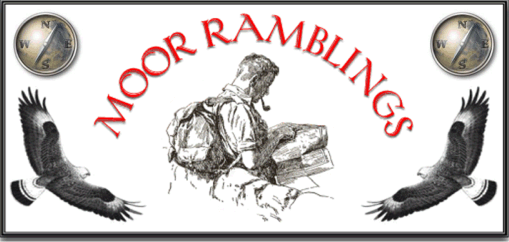
Rule number one – never visit Dartmoor on a Bank Holiday weekend, especially if it’s near the Ten Tors week. Why? because every nook and cranny is crawling with people and this May holiday was no exception. We arrived at the car park in Princetown smack on the first chime of 8.00am and the whole shooting match was clogged with large white minibuses and bedraggled youths. It was a cold, jaundiced morning with a sallow hue to the sky, the only warmth flared out from my last tether as I just managed to squeeze the car into the only available parking space between two white school buses. The only highlight of the whole experience was to find that for the first time ever ‘Zeb’ had not spewed all over the boot – nice one Zeb, have a Bonio.
We were walking with Sam and Rose who had arrived earlier and found a sensible parking spot and as I struggled to put my boots on amidst a throng of youths he came over with a look that said, “you’re about to go off on one,” – too true blue! The plan was to traipse down to the ruins of John Bishop’s House and on the way call in at the various Bronze Age remains on Royal Hill then return back via the Devonport Leat, I like walking leats they’re flat and easy.
It did not take long to leave the bedlam of Princetown and strike off onto the moor just past Bull Park where Conchies Road begins. This track is so called because it was partially rebuilt or upgraded by conscientious objectors in World War One, if there ever was a World War Three I don’t think there would ever be a problem repairing it. Sauntering down the track it did not take long to see all the new additions to Dartmoor, it was if as the very ground was shaking and bouncing with young lambs. Everywhere were snow-white balls of wool in various modes of activity which ranged from the manic, through to the hungry, and finishing up with the fast asleep. Those that were awake filled the air with a frantic cacophony of bleating and I am not sure if this was because they wanted their mothers or they had just seen Zeb straining at the lead in an effort to go and play with them. Luckily the dog found better amusement in the form of a thick, stinking, peaty bog which he duly launched himself into with great gusto.
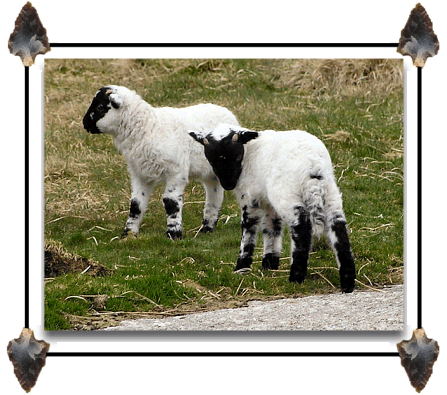
We soon reached the first Bronze Age remains in the form of a kist with a retaining stone circle, this one was known as the ‘Crock of Gold‘, a name alluding to the treasure thought to be found buried in the chest. It is now that something tells you that you are stood on the vestiges of a very ancient and sacred landscape.
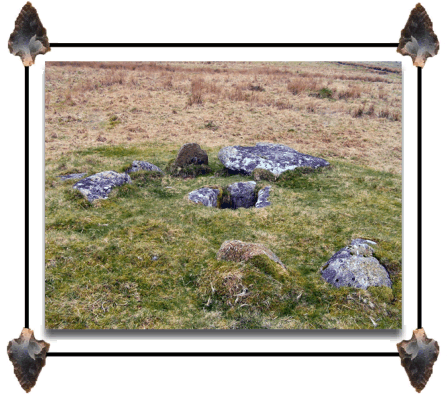
The Crock of Gold.
From the Crock of Gold the north eastern horizon pans out over Bellever tor which if tradition is to be believed is named after the sun god Bal and is the centre of Dartmoor and posses its own extensive range of ritual monuments. As with most of Dartmoor a careful look at the landscape reveals centuries of man’s activities with each endeavour overwriting those of previous generations. From Royal Hill you can see the early prehistoric features and then imposed over them is evidence of tin workings which in turn have been merged with aspects of later agricultural improvements.
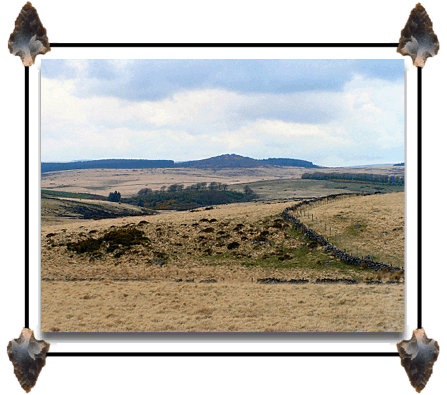
The view across to Bellever from the Crock of Gold
On cresting the ridge at Royal tor two more cairns come into view and in my opinion the first of the two is by far the best to be seen on Royal Hill, the bottom of the two being known as Brokenborough which again would suggest that at some time the grave had been robbed for its supposed treasure. Descending the hillside we made our way down to the lower enclosure that run alongside the river Swincombe where a distinct trackway leads down to the old Higher Swincombe ruins. It was here where a man called John Toop lived and farmed in 1839 and besides which stands the later ruins of Swincombe Farm, originally this was built as a ‘fishing retreat for the Tor Royal estate. The one huge remaining gate pillar is said to have marked the extent of the estate along with its long lost partner. This smallholding was built in 1912 and was the home of the Chudley family who dwelt here until 1955. Just below these two farms lies the sturdy ruins of John Bishop’s house which is noted for its impressive granite porch. Originally the house was known as Swincombe Ford Cottage and was built sometime around the 1827. It is known that in 1831 the owner was one Henry Sparkes as the parish registers show that his wife, Elizabeth, died in this year. Henry was listed in the 1841 census returns as being a tin miner, he may have possibly worked at the nearby Gobbet mine. Originally the house consisted of a two storey thatched cottage, garden, two arable plots, and two pasture plots. Henry Sparkes died in 1843 and sometime between then and 1848 John Bishop moved in, obtaining a 21 year lease from the Duchy in 1843 when the house became known as John Bishop’s House. For all his life, poor old John had to cross the river Swincombe by means of some stepping stones which depending on the height of the river was either easy or perilous. It was only after he died in 1892 that a footbridge was erected over the river, tradition has it that John always said once it was possible to drive over the river as opposed to through it there would be nothing else wanted on Dartmoor. After his death the lease passed on to his wife Elizabeth and then in 1896 there was a fire which destroyed the thatch roof and damaged much of the interior. It was at this point that Elizabeth moved to Whiteworks and the lease was passed on to her daughter Fanny. After the fire the thatched roof was replaced with a slate one and in 1899 a ‘luxurious’ outside privvy was added, around about the same time the house was sub-let to William Coaker who lived here until 1908. In 1908 the house was let to Henry Worth who remained her until Fanny Bishop’s lease ran out in 1911. The property was then sold by the Duchy to Thomas Coaker after which it appears the house remained unoccupied and turned into shippens.
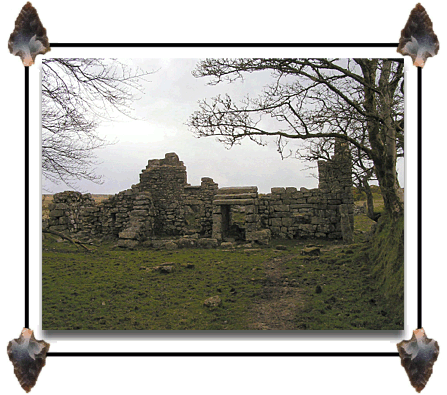
The following years saw the gradual decline of the house until 1969 when a BBC film producer called John King used it in a film called ‘The Stallion’. Once again like a phoenix, John Bishop’s House, rose from the ashes because in order to use it in the film some restoration work was carried out which it is thought included the fitting of an asbestos roof and a new door.
By the 1970’s the roof had fallen in, the top floor joists had collapsed, and the back wall caved in. In 1986 the National Park carried out some restoration work on the porch, doorway and front windows to stop any further deterioration.
Today it is the lair of a herd of Galloway and other cattle who are doing a sterling job of further adding to the dilapidation of the house. Why on earth does the National Park not insist on the ruins being fenced off? There are thousands of pounds wasted each year on trivial grants and projects and nobody can be bothered to protect what heritage is left. For instance in 2005 the sum of £3,500 was given to produce a play where young people highlighted their aspirations, £5,000 was doled out to promote the use of re-cycled materials in art and crafts, and £6,300 went to children who, “found school difficult (some of them excluded),” so they were to able to experience conservation work. Bloody marvellous, £14,800 which would have easily paid for some fencing and given plenty of experience of conservation work.
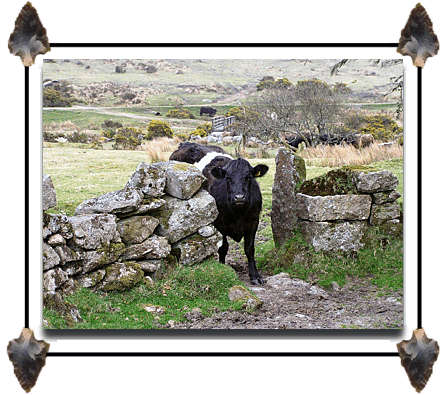
Are my ears burning ?
As we were not on a marathon the path home led back up the track and across Royal Hill, the alternative and circular route would have been to cross the Swincombe at Fairy Bridge (which can be seen above the back of the Galloway in the above picture) and return to Princetown via Hexworthy(ish).
At this point I should say a bit about Sam, no matter where you go or what you are looking for Sam will find it. I have been down various mines with him and you can guarantee that he will always find the best specimens, and in a similar light he will always find something hidden somewhere. I am sure he could spot a ten pound note pinned to a tree in the middle of a wood from two miles away. Today was no exception, as we all trundled back up across the foot of Royal Hill he nonchantly bent down and picked something up. “Ooo a flint,” he said, now as there is no naturally occurring flint anywhere on Dartmoor this meant only one thing – it was prehistoric, but one flint does not an arrowhead make. So about 50 paces further on he swooped down and picked up another one, I was gutted because to me there is nothing more amazing than to pick something up that you know was last handled 4,000 years ago. Then low and behold a few feet away from where he was stood I spotted two more flint fragments embedded in the soil. This was perfect, not only had we visited the graves of the Bronze Age moor dwellers we had actually found remnants of something they were making. More to the point we had actually stood where someone either sat knapping flint, lost or discarded some unwanted flakes as they walked along, it may have even been someone that was buried in the kists, highly unlikely but just possible. A few hundred yards up the track Angela found another flint fragment – Time Team eat you heart out and not even a JCB in sight.
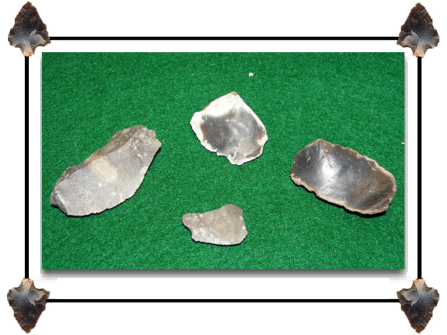
Flint ‘treasure’
On returning back to Bull Park it was decided to walk back along the Devonport Leat which by its very nature meant a gentle stroll. It was also an ideal chance to have a brown dog instead of a peat black one, to which end poor old Zeb was unceremoniously plunged in to the leat, black, stinking dog in, brown, bedraggled dog out, perfect. Leats are superb places to see wildlife, there are insects, fish and birds in abundance. My favourite sight in a leat is the Dipper, there is just something ‘special’ about this little white bibbed bird but sadly today there were none. Trout were scudding through the weed, occasionally erupting in a vortex of ripples as they dined on the insects above. I had never been along this stretch of the leat before and was amazed at the number of ‘sheep leaps‘ along its length. These simple and ingenious inventions consist of two granite slabs, one each side of the leat, designed to provide a ‘launch pad’ and ‘landing ramp’ for sheep who wanted to cross the leat. I have never actually seen a sheep use one but in days gone by have used them myself.
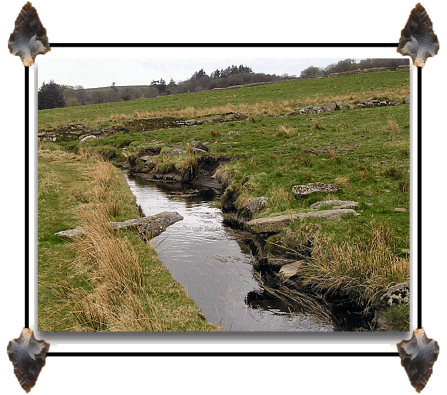
A Sheep Leap.
Whilst trundling along we spotted a heron lazily flapping down to the Blackbrook below. Obligingly, ‘Old Nog’ stood motionless as he carefully eyed the waters for a unwary fish to swim by. ‘Twas a nice end to a relaxing walk, even Zeb was impressed as he stood just as still peering down at the large bird below.
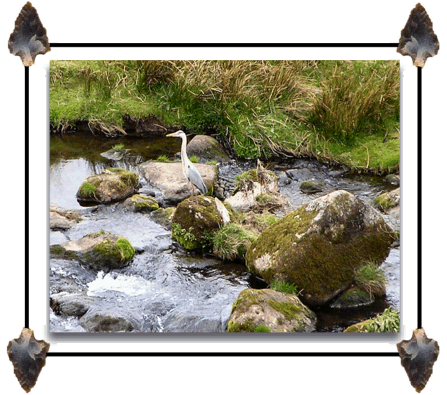
The leat eventually bring you out on the B3212 road directly opposite Dartmoor Prison which gave me a chance to get a photo of it. The reason being that I have an old postcard of the prison and I wanted to try and take a picture from the same viewpoint the original photographer took, just to see how much the place has changed over time.
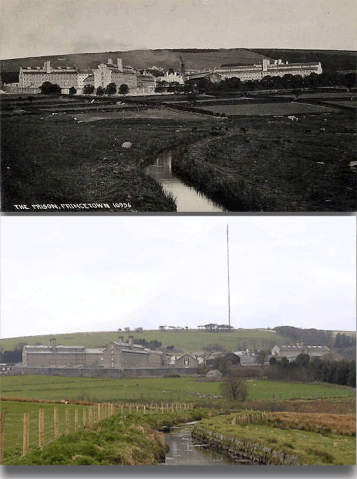
Dartmoor Prison – then and now.
As you can see, surprisingly little, ok the large block on the right has gone and the Hessary Mast has appeared on the horizon but apart from that very little. By the time we had returned to the car park the scene had transformed itself, not a large white minibus in sight or a gangly youth in gaiters that reached up to the thighs. Instead there were cars, buses, people slurping ice creams, dogs crapping on the green, and more people. I wonder how many hundreds of “Property of Dartmoor Prison,” souvenir mugs have been sold today?
 Legendary Dartmoor The many aspects past and present of Dartmoor
Legendary Dartmoor The many aspects past and present of Dartmoor

Thanks Tim for posting this, as it answered our query today as to what a large gatepost was doing seemingly in the middle of nowhere. And now we know it was the gatepost to an old estate. Thank you!
A photograph of the inside of the doorway appears today on Instagram. It brought me to these pages, which provide much more detail and history of the area. Thank you.
Interested to read about Swincombe. In the early 60s me and about 15 boys from my prep school in Taunton ‘camped’ for a week in the old house. It had an upstairs then and a lean-to kitchen out the back. It was January and b….. cold! We were all under 12 at the time, which seems incredible in this day and age. Long treks across the moor, walk to church on the Sunday and meals by Tilley lamplight.
One night we were woken by police at the door – a prisoner had escaped from Princetown prison and would we check all the outhouses! Very exciting at the time but in retrospect could have been a bit serious.
I have been back to Swincombe several times since, most recently in 2019. Very sad to see the old place in ruins.
Exellent , I live close by and often drink my tea there , I often also wondered about the history, brilliant read .
Very useful and detailed history, many thanks. Walked there yesterday for the first time in 15 years. The original track past the farm and house is now in poor (ie wet and stony) condition, but interesting to look around and wonder how on earth they made a living!
Thankyou. Grateful you could answer a few of my questions after my rambling through there. Surprised to discover Ford cottage was not as old as I imagined. It’s collapsing quite rapidly ( agreed with your sentiments, thought same on arrival). Left wondering as others said- How could make a living there. No local wood for fire The arable plot seems stoney and prone to flooding. What we’re they eating? Such effort to have lumped all that granite in its creation. – further off on the higher climbs amongst the granite , I noticed some stones that were at odds. One even seemed to be like a worn away grave stone. I found an old rusty cast horseshoe there about. Mounted on my door for now.